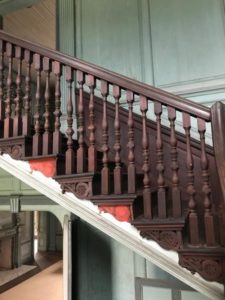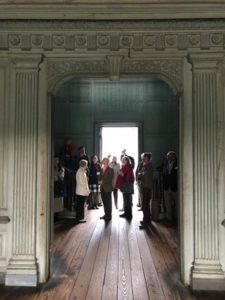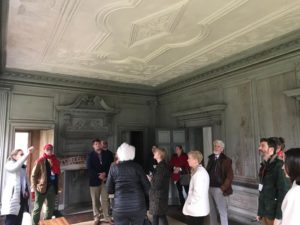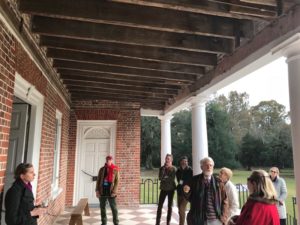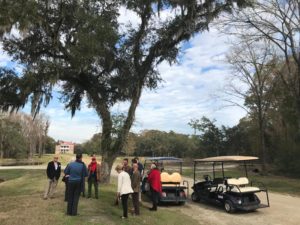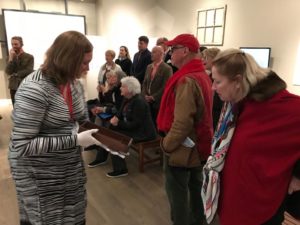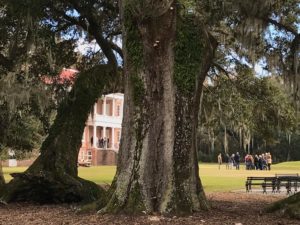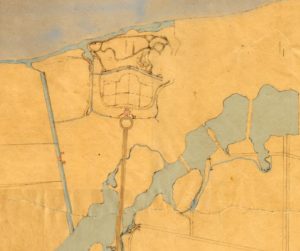Impressive Research & Facilities Bring Drayton Hall Experience to New Heights
EVENTS > SPECIAL PROGRAMS
REVIEW: DRAYTON HALL SPECIAL PROGRAM, WINTER 2018
In spite of a three-month delay following Hurricane Florence’s untimely arrival in the Southeast, the day-long seminar hosted on December 7 by the Drayton Hall Preservation Trust in collaboration with the Decorative Arts Trust provided participants with an in-depth exploration of this extraordinary site as well as a recently completed project that vastly enhances the visitor experience.
Drayton Hall’s new $6 million Sally Reahard Visitors Center represents the culmination of a capital campaign to improve the stewardship of historic resources and expand interpretation and public programming. Set in a stand of trees apart from the house at a sensitive distance, the sequence of buildings is centered around a courtyard featuring a grand oak tree and the tranquil Lenhardt Garden. In addition to housing a store and café, an essential function of the new facility is the Stephen and Laura Gates Gallery, a formal museum space for Drayton’s collection and changing exhibitions. The gallery offers the first such opportunity to share the range of objects that contextualize the experience of those who occupied the site while the McDaniel Education Center serves as a purpose-built venue for academic programs.
The speakers highlighted ongoing research into the design, decoration, and function of Drayton Hall. Trish Smith, Curator of Architectural Research at Drayton, offered a candid assessment of the house’s connection to Palladian architecture, setting the tone with a recitation of Alexander Pope’s 1732 poem to architect Lord Burlington, titled “Of False Taste.” Pope’s verse acknowledges the failures of “imitating fools” who “many blunders make” in pursuit of classical design. Although John Drayton remains shrouded in the cloak of a vague historical record, his extensive architectural library provided sufficient resources to avoid those mistakes in the design of the house and interiors. Smith placed the house on a Palladian design continuum that acknowledged Drayton’s thorough understanding of the architectural patterns and concepts that define Palladio’s work. Drayton Hall demonstrates the desire for order, hierarchy, and compartmentalization as well as the refined ornament, fabrics, and conveniences expected of a gentleman’s country seat.
Paint analysis guru Susan Buck shared findings gathered from more than a decade of research into Drayton’s exterior and interior surfaces. Among the most incredible facets of the house’s evolution is the notion that the rooms were only painted three or four times in 200-plus years of occupation. The first two applications are the original coat and a second added later in John Drayton’s life or by his son Charles after acquiring this house from his stepmother in 1784. The original colorway was a largely monochromatic scheme in yellow ochre. Buck has pinpointed additional flourishes, however, including a brilliant red-orange stain on the mahogany staircase and evidence of gilding on a carved molding in the dining room overmantel, which likely framed a painting or mirror. The unrestored blue-green layer that visitors encounter today is the most recent coat, added in the late 19th century when the Drayton family enjoyed a financial windfall from phosphate mining. An important question currently under consideration by Drayton’s staff and board is whether to return the house’s iconic portico to the original yellow ochre color or to continue with the brilliant white introduced when the National Trust for Historic Preservation acquired the site in the 1970s.
Gabby Angeloni, who received a summer research grant from the Decorative Arts Trust in 2017, presented her dissertation research into the libraries established by Low Country plantation owners in the 18th and early 19th centuries. In addition to documenting the book trade in Colonial Charleston, Gabby has investigated the furnishings and treatises displayed in the domestic settings where wealthy South Carolinians demonstrated their learned and cultured upbringing. Charles Drayton, who studied medicine in Edinburgh, was particularly keen on cultivating this appearance.
Our afternoon tours of the museum, house, and landscape offered participants the opportunity to place information gleaned during the morning presentations into context. Trish and Susan led an exploration of the house with Ed Chappell, the retired director of Colonial Williamsburg’s architectural research department. With Trish’s commentary on 18th-century design sources and Susan’s explanation of interior finishes percolating, Ed shared his insight into the structure, decoration, and function of the grand house. He described the interior communication of rooms as “porous” given the multiple access points to most spaces, which permitted the unobstructed flow of visitors, family members, and servants. This feature ties Drayton Hall to Palladio’s 16th-century designs for country villas.
The new museum center was introduced by Sarah Stroud Clarke, Curator of Collections at Drayton, and Chris Swan, Conservator of Furniture and Wooden Artifacts at Colonial Williamsburg. Chris spearheaded the conservation and restoration of numerous Drayton family furnishings, including an exceptional mid-18th-century English desk and bookcase. Sarah and Chris guided the group through an exploration of the desk’s ornamentation and the multitude of compartments hidden within the interior. This object testifies to the level of refinement John Drayton wished to portray to his guests. The full breadth of Drayton Hall’s material culture is on view, however, from objects passed down through generations of the family to fragments recovered from the archaeological record. A rare branding iron documents the treatment of the enslaved communities through which the family generated the wealth necessary to build, furnish, and maintain Drayton Hall.
Erik Becker, Manager of Landscapes and Horticulture, charted a revelatory tour of the grounds that surround Drayton Hall, explaining the considerable resources John and Charles Drayton invested to emulate English garden designs. The processional drive leading up to the house is flanked by ornamental ponds, a late-19th-century adaptation to the inland cultivation of rice that generated the Drayton’s wealth. Paths allowed the family and guests to enjoy the tree-lined property and extensive gardens laid adjacent to grazing pastures, with ha-has dug to keep livestock at bay. A c. 1747 garden house built by John Drayton along the Ashley River is no longer extant but likely served as an entertaining space. Archaeological excavations unearthed the fragments of a chandelier, porcelain, and glassware.
In spite of the recent focus on all facets of Drayton Hall’s history, numerous questions about the house and plantation remain unanswered. What is clear, however, is that unlike the blunders made by Pope’s “imitating fools”, John and Charles Drayton’s contributions to 18th-century American architecture and landscape design remain sources of amazement worthy of continued research. We look forward to returning for another exploration of the site’s layered past.

